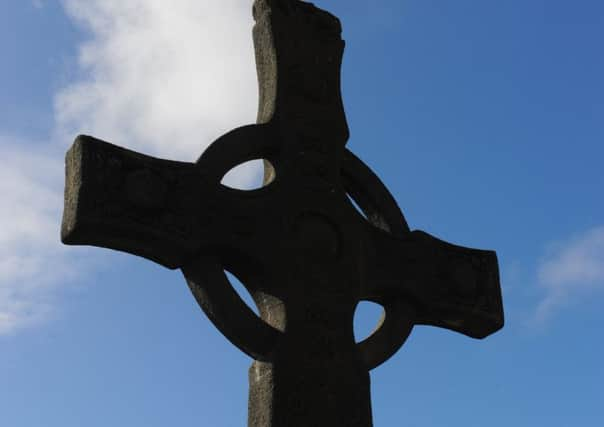Alistair Moffat: Scotland’s links with Ireland and the Vikings


Made from cowhides caulked with fat or resin and lashed on to a frame of whippy, green rods stiffened by thwarts used as benches, sea-going curraghs were so light that they sat on the wave-crests like seagulls.
Ancient craft noted in a seventh century Scottish muster roll known as the Senchus Fer na h’Alban, they could be large, “seven benchers” rowed by crews of 14 men. On the southern coast of Iona, a place-name remembers curraghs making landfall, pulled up on to the beach above the high tidemark. More than time-worn tradition, Port a’ Curraich may indeed be the place where Columba first splashed ashore on the island that would become a memorial to his saintly, exemplary life.
Advertisement
Hide AdAdvertisement
Hide AdThe first Abbot of Iona may have been the most famous and most influential, but he was one of many thousands who left Ireland to cross the North Channel in their sea-going curraghs in the centuries after c500AD. It is possible to be sure that thousands came after that date because of research carried out by ScotlandsDNA over the past four years. Our geneticists have discovered a Y chromosome marker that remembers those voyages through the powerful riptides between the Irish coast and the Galloway shore. Labelled R1b-S661, it arose in Ireland and was almost certainly the marker of the powerful Ui Neill, the kindred who claimed descent from the first High King of Ireland, Niall Noigiallach. It is found in very large numbers of Irishmen: 35 per cent of all those in Connaught, 31 per cent in Leinster and 29 per cent in Ulster. It is believed that Niall ruled some time around the beginning of the fifth century.
Hidden inside these statistics is evidence of a real and long-lasting genetic divide in Scotland. Because the steersmen of curraghs and the craft that came after them could see the hills of the Scottish coast from the Antrim shore, at least on a fine day, most of the descendants of Niall Noigiallach settled in the west of Scotland. In Glasgow, Strathclyde and Dumfries and Galloway, the evidence for migration now walks the streets as 10 per cent of all men in those regions, about 150,000, have royal Irish blood running in their veins. By contrast, in Fife, Perthshire and Tayside, only 5 per cent can claim descent from the High King and in the north and west, the frequency declines to 3.7 per cent. These numbers trace an ancient pattern of Irish settlement in Scotland.
Despite a dramatic increase in social mobility in modern times, the map of Scotland still shows the clear watermark of the movement of people in the mists of prehistory and the ancient political divides they created. Scandinavian and Germanic haplogroups are often markedly more common amongst men who live along the eastern, North Sea coasts. Perhaps that is to be expected, but one fatherline, labeled I-S142, appears to remember the shadow of a Dark Ages kingdom, the frontiers of the realm of Northumbria. Men in this haplogroup make up 9 per cent of the male population of the north of England, 6 per cent of Yorkshire – and, strikingly, more than 4 per cent in the southe-east of Scotland with a distinct bias to the Tweed Basin. This fertile and valuable region of modern Scotland formed part of the kingdom of Northumbria until the pivotal Battle of Carham in 1018. Until then the Tweed was a conduit, not a frontier.
At Dunnichen, an ambitious king of Northumbria was killed as he tried to extend his reach north of the Tay. Ecgfrith’s defeat and his nemesis were triumphantly carved on the famous stone in Aberlemno kirkyard in Angus, between Forfar and Brechin. Bridei, king of the Picts, rides across the face of the stone with his soldiers and in the last sequence, Ecgfrith is shown unhorsed and his corpse pecked at by a raven. Dunnichen was fought in 685 and Pictland survived and flourished for another 150 years – until it suddenly appeared to disappear. All that seemed to remain of this powerful Scottish polity was a scatter of place-names and enigmatic symbol-stones across Fife, Perthshire, Tayside, Aberdeenshire and the Moray coastlands. The Pictish language fell entirely out of use and their kings and noble families seemed to fail.
But DNA did not forget the Picts. In 2013 ScotlandsDNA rediscovered a Pictish Y chromosome haplogroup, R1b S749. It is old, about 1,000 to 2,000 years old, and it shows that the Pictish kingdoms and their strange symbols were not the creation of recent immigrants. R1b S749 is very Scottish with 10 per cent of men carrying it compared with only 0.8 per cent in England. In addition its frequency inside Scotland overlays the faded map of ancient Pictland with 17 per cent of all men in Central Scotland carrying it, and 14 per cent in North-east Scotland, with a decline towards northern and western Scotland at 8 per cent and south east and south west Scotland at 6 per cent. These differences are very statistically significant and they show that far from disappearing, the Picts have not wandered far.
Ancestral DNA has discovered something else of significance. Scotland is fissured with invisible frontiers, hidden in our genes. It is an unwritten history of our people carried inside each and every one us.
• For more information, e-mail [email protected] or call 0345 4502483.
• To read the full extended version of this article, go to www.scotsman.com/lifestyle/heritage
• Next Friday: Part 4 – How many thousands of Scots are descended from warriors, patriarchs or kings.